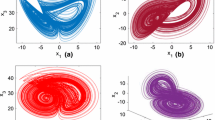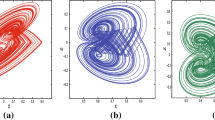Abstract
Hyper-chaotic systems can exhibit a higher level of complexity in comparison with the chaotic systems. However, they require more resources when they are realized on a modular field-programmable gate array (FPGA). In this paper, we introduce full hardware/software comparison and security analysis of three-dimensional chaotic and four-dimensional hyper-chaotic oscillator systems. The two systems (previously implemented only in analog form) are realized on a modular FPGA hardware platform to generate high-speed random bit-streams. The realization is performed using two versions of VHDL code, one is generated automatically using a MATLAB HDL-Coder, and the optimized one which is manually written. The work explores the features of each oscillator system such as throughput, FPGA resources utilization, operating clock frequency, and security of the generated bit-streams, to show a compromise solution on these features. The experimental results show that the hyper-chaotic oscillator has higher level of security than the chaotic one, but it is slower and utilizes more FPGA resources. However, when the overall comparison measure figure of merit (FOM) is used, the chaotic system shows 188% better FOM than the hyper-chaotic system (for the automatically generated version) and 183% (for the manually written one).












Similar content being viewed by others
Data Availability
This study has no associated data.
References
F. Almutairi, T. Bonny, new image encryption algorithm based on switching-type chaotic oscillator, in IEEE International Conference on Electrical and Computing Technologies and Applications, Ras Al Khaimah, UAE, November 2019 (2019)
L. Avalos-Ruiz, C. Zuniga-Aguilar et al., FPGA implementation and control of chaotic systems involving the variable-order fractional operator with Mittag–Leffler law. Chaos Solitons Fract. 115, 177–189 (2018)
J.M. Bahi, X. Fang, C. Guyeux, L. Larger, FPGA design for pseudorandom number generator based on chaotic iteration used in information hiding application. Appl. Math. Inf. Sci. 7(6), 2175–2188 (2013)
T. Bonny, et al., An adaptive hybrid multiprocessor technique for bioinformatics sequence alignment, in International Conference on Biomedical Engineering Conference (2010)
T. Bonny, J. Henkel, LICT: left-uncompressed instructions compression technique to improve the decoding performance of VLIW processors, in Design Automation Conference (DAC09), USA, pp. 903–906 (2009)
T. Bonny, A.S. Elwakil, FPGA realizations of high speed switching-type chaotic oscillators using compact VHDL codes. J. Nonlinear Dyn. 93, 819–833 (2018)
T. Bonny, J. Henkel, Instruction re-encoding facilitating dense embedded code. Des. Autom. Test Eur. 4484772, 770–775 (2008)
T. Bonny, Q. Nasir, Clock glitch fault injection attack on an FPGA-based non-autonomous chaotic oscillator. Nonlinear Dyn. 96(3), 2087–2101 (2019)
T. Bonny, T. Rabie, A.H.A. Hafez, Multiple histogram-based face recognition with high speed FPGA implementation. Multimed. Tools Appl. 77(18), 24269–24288 (2018)
T. Bonny, R. Aldebsi, S. Majzoub, A. Elwakil, Hardware optimized FPGA implementations of high speed true random bit generators based on switching-type chaotic oscillators. J. Circuits Syst. Signal Process. 38, 1342–1359 (2019)
G. Chen, T. Ueta, Yet another chaotic attractor. Int. J. Bifurc. Chaos 9, 1465–1466 (1999)
S.-L. Chen, T. Hwang, S.-M. Chang, W.-W. Lin, A fast digital chaotic generator for secure communication. Int. J. Bifurc. Chaos 20, 119 (2010)
A. Coronel-Escamilla, J.F. Gomez-Aguilar, L. Torres, R.F. Escobar-Jimenez, M. Valtierra-Rodriguez, Synchronization of chaotic systems involving fractional operators of Liouville–Caputo type with variable-order. Physica A 487, 1–21 (2017)
L. De Micco, H.A. Larrondo, Methodology for FPGA implementation of a chaos-based AWGN generator, in Field-Programmable Gate Array (FPGA) Technologies for High Performance Instrumentation, ed. by J.D.D. Gazzano (IGI Global, Hershey, 2016)
L. Dieci, Jacobian free computation of Lyapunov exponents. J. Dyn. Differ. Equ. 14(3), 697–717 (2002)
Digilent, Inc, www.zedboard.org (2016). Accessed 2020
S. Ergun, S. Ozoguz, Truly random number generators based on a non-autonomous chaotic oscillator. Int. J. Electron. Commun. 61, 235–242 (2007)
J.E. Escalante-Martínez, J.F. Gomez-Aguilar, C. Calderon-Ramon, A. Aguilar-Melendez, P. Padilla-Longoria, A mathematical model of circadian rhythms synchronization using fractional differential equations system of coupled van der Pol oscillators. Int. J. Biomath. 11(01), Article 1850014 (2018)
X. Fang, Q. Wang, C. Guyeux, J.M. Bahi, FPGA acceleration of a pseudorandom number generator based on chaotic iterations. J. Inf. Secur. Appl. 19(1), 78–87 (2014)
R.L. Filali, M. Benrejeb, P. Borne, Observer-based secure communication design using discrete-time hyperchaotic systems. Commun. Nonlinear Sci. Numer. Simul. 19(5), 1424–1432 (2014)
A.L. Fitch, D. Yu, H.H.C. Iu, V. Sreeram, Hyperchaos in an memristor-based modified canonical Chua’s circuit. Int. J. Bifurc. Chaos 22, 1250133–8 (2012)
R. Gupta, A. Pandey, R.K. Baghel, FPGA implementation of chaos-based high-speed true random number generator. Int. J. Numer. Modell. Electron. Netw. Devices Fields 2019, e2604 (2019)
http://csrc.nist.gov/groups/ST/toolkit/rng/documentation_software.html. Accessed 2020
https://www.nutaq.com/matlab-hdl-coder-xilinx-system-generator. Accessed 2020
Inc, X.: 7 Series FPGAs Overview, vol. 1. Xilinx (2014)
M.P. Kennedy, Robust OP AMP realization of Chua’s circuit. Frequenz 46, 66–80 (1992)
M.P. Kennedy, Chaos in the Colpitts oscillator. IEEE Trans. Circuits Syst. I Fund. Theor. Appl. 41, 771–774 (1994)
J.M. Kowalski, G.L. Albert, G.W. Gross, Asymptotically synchronous chaotic orbits in systems of excitable elements. Phys. Rev. A 42(10), 6260–6263 (1990)
I. Koyuncu, A.T. Ozcerit, The design and realization of a new high speed FPGA-based chaotic true random number generator. Comput. Electr. Eng. 58, 203–214 (2017)
I. Koyuncu, A.T. Ozcerit, I. Pehlivan, Implementation of FPGA-based real time novel chaotic oscillator. Nonlinear Dyn. 77(1–2), 49–59 (2014)
I. Koyuncu, M. Tuna, I. Pehlivan, C.B. Fidan, M. Alçın, Design, FPGA implementation and statistical analysis of chaos-ring based dual entropy core true random number generator. Analog Integr. Circuits Signal Process. 102, 445–456 (2020)
C.-Y. Li, Y.-H. Chen, T.-Y. Chang, L.-Y. Deng, K. To, Period extension and randomness enhancement using high-throughput reseeding-mixing PRNG. IEEE Trans. Very Large Scale Integr. Syst. 20, 38538 (2012)
Q. Li, H. Shiyi, S. Tang, G. Zeng, Hyperchaos and horseshoe in a 4D memristive system with a line of equilibria and its implementation. Int. J. Circ. Theor. Appl. 42, 1172–1188 (2014)
J. Ma, P. Zhou, B. Ahmad, G. Ren, C. Wang, Chaos and multi-scroll attractors in RCL-shunted junction coupled Jerk circuit connected by memristor. PLoS ONE 13(1), e0191120 (2018)
M. Park, J.C. Rodgers, D.P. Lathrop, True random number generation using CMOS Boolean chaotic. Microelectron. J. 46(12), 1364–1370 (2015)
V.T. Pham, S. Vaidyanathan, C. Volos, E. Tlelo-Cuautle, F.R. Tahir, A memristive system with hidden attractors and its engineering application, in Advances in Memristors, Memristive Devices and Systems, vol. 701, Studies in Computational Intelligence, ed. by S. Vaidyanathan, C. Volos (Springer, Cham, 2017)
M. Qiu, S. Yu, Y. Wen et al., Design and FPGA implementation of a universal chaotic signal generator based on the Verilog HDL fixed-point algorithm and state machine control. Int. J. Bifurc. Chaos 27(3), 1750040–1750055 (2017)
A.A. Rezk, A.H. Madian, A.G. Radwan, A.M. Soliman, Reconfigurable chaotic pseudo random number generator based on FPGA. AEU Int. J. Electron. Commun. 98, 174–180 (2018)
O.E. Rossler, An equation for continuous chaos. Phys. Lett. A 57, 397–398 (1976)
O.E. Rossler, An equation for hyperchaos. Phys. Lett. A 71, 155–157 (1979)
A. Rukhin, et al., A statistical test suite for random and pseudorandom number generators for cryptographic applications, NIST Special Publication 800-22 (2001)
B. Sunar, True random number generators for cryptography, Cryptographic Engineering (Springer, Boston, 2009). https://doi.org/10.1007/978-0-387-71817-0_4
E. Tlelo-Cuautle, A. Quintas-Valles, L. de la Fraga, J. Rangel-Magdaleno, VHDL descriptions for the FPGA implementation of PWL-function-based multi-scroll chaotic oscillators. PLoS ONE 11(12), e0168300 (2016)
M.F. Tolba, A.S. Elwakil, H. Orabi, M. Elnawawy, F. Aloul, A. Sagahyroon, A.G. Radwan, FPGA implementation of a chaotic oscillator with odd/even symmetry and its application. Integration 72, 163–170 (2020)
F.J. Torres, G.V. Guerrero, C.D. García, J.F. Gomez, M. Adam, R.F. Escobar, Master–slave synchronization of robot manipulators driven by induction motors. IEEE Latin Am. Trans. 14(9), 3986–3991 (2016)
Xilinx, Vivado design suite—hlx editions (2016)
X. Yu-meng, Z. Yao, A. Hobiny, J. Ma, Differential coupling contributes to synchronization via a capacitor connection between chaotic circuits. Front. Inf. Technol. Electron. Eng. 20, 571 (2019)
C.J. Zuniga-Aguilar, H.M. Romero-Ugalde, J.F. Gomez-Aguilar, R.F. Escobar-Jiménez, M. Valtierra-Rodríguez, Solving fractional differential equations of variable-order involving operators with Mittag–Leffler kernel using artificial neural networks. Chaos Solitons Fract. 103, 382–403 (2017)
C.J. Zuniga-Aguilar, A. Coronel-Escamilla, J.F. Gomez-Aguilar et al., New numerical approximation for solving fractional delay differential equations of variable order using artificial neural networks. Eur. Phys. J. Plus 133, 75 (2018)
C.J. Zuniga-Aguilar, J.F. Gomez-Aguilar, R.F. Escobar-Jimenez et al., Robust control for fractional variable-order chaotic systems with non-singular kernel. Eur. Phys. J. Plus 133, 13 (2018)
C.J. Zuniga-Aguilar, J.F. Gomez-Aguilar, R.F. Escobar Jimenez, H.M. Romero Ugalde, A novel method to solve variable-order fractional delay differential equations based in Lagrange interpolations. Chaos Solitons Fract. 126, 266–282 (2019)
Funding
The research did not receive any specific grant from funding agencies in the public, commercial, or not-for-profit sectors.
Author information
Authors and Affiliations
Corresponding author
Ethics declarations
Conflict of interest
The authors declare that they have no conflict of interest.
Additional information
Publisher's Note
Springer Nature remains neutral with regard to jurisdictional claims in published maps and institutional affiliations.
Rights and permissions
About this article
Cite this article
Bonny, T. Chaotic or Hyper-chaotic Oscillator? Numerical Solution, Circuit Design, MATLAB HDL-Coder Implementation, VHDL Code, Security Analysis, and FPGA Realization. Circuits Syst Signal Process 40, 1061–1088 (2021). https://doi.org/10.1007/s00034-020-01521-8
Received:
Revised:
Accepted:
Published:
Issue Date:
DOI: https://doi.org/10.1007/s00034-020-01521-8




